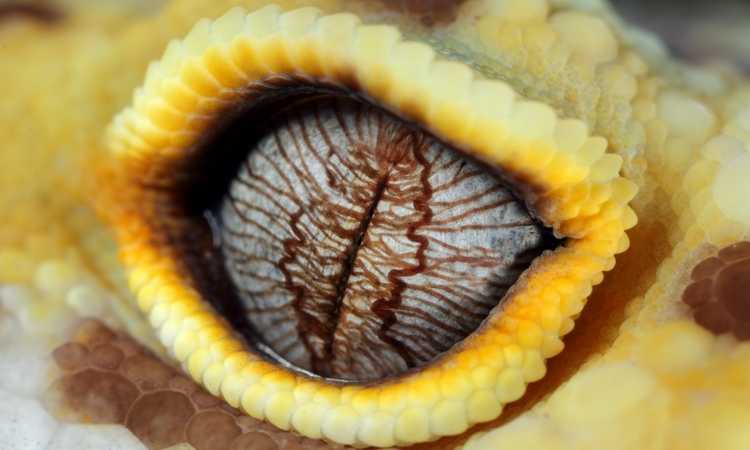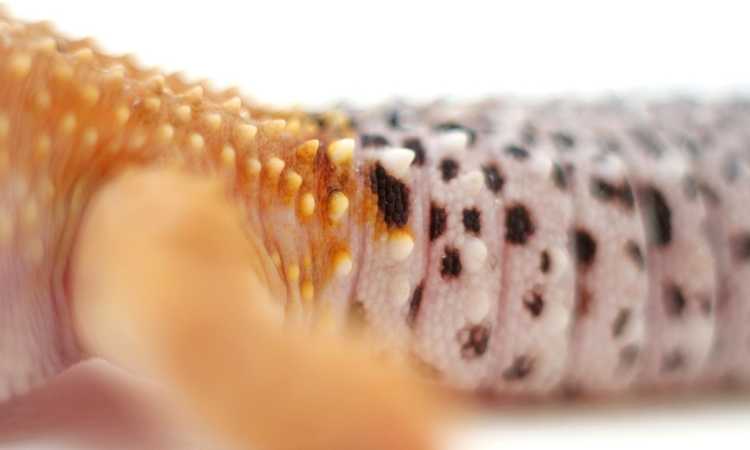Geckos are amazing creatures. They can climb walls and even walk on ceilings! But what makes them so special? Part of it has to do with their anatomy. For example, did you know that geckos have eyes that help them see in the dark? Or that their tails can act like a parachute? Read on to learn more about the amazing anatomy of geckos!

A gecko’s incredible eyes
You might be surprised to learn that leopard geckos can see well. Their ability to see is crucial to their ability hunt and get food. The leopard gecko is first attracted to the movement of their prey (insects), and then the movement is recorded and the insect is identified as prey or not. This task is well suited for the leopard gecko’s eyes. Leopard geckos are nocturnal hunters and have vertically slit pupils. This allows more light to enter the eye when there’s less light.
One of their other adaptations that allows them to see in the dark is the fact that many cones in their eyes (which enable the eye see color) have become rods over time. Scientists aren’t sure if leopard geckos and other nocturnal geckos can see color or how much, but it is clear from their behavior that they are able see shapes, movements, and outlines even in low light conditions.
Leopard geckos can move their eyelids. While most gecko species have permanent eyelids, which are immovable (their eyes remain open like snakes), leopard geckos can still close their eyes. The bottom eyelid closes; it moves upwards. Nearly every creature on the planet with eyes that can close has an upper one that closes.
Leopard geckos are also capable of licking their eyes. At times, you may be looking at your gecko and suddenly a pink tongue appears. It will quickly swipe across the surface of an eye. Experts disagree on why leopard geckos do it. Some believe it’s a cleaning mechanism. The tongue cleans the eye of any debris. Others disagree, and believe the gecko is getting moisture from the eyes.
Read This: What Should I Feed My Leopard Gecko?

Gecko feet are amazing!
Arboreal geckos can run up vertical surfaces or hang from the undersides of houses. Their feet are the reason these geckos can be great escape artists when they are kept as pets. The feet are lined with keratin bristles, which allow the gecko to stick to almost any surface.
The clinging bristles of arboreal geckos are not as numerous for leopard geckos. They don’t have the bristles that terrestrial geckos do. Instead, leopard gecko feet are able to dig under rocks and cross sandy soil. Leopard gecko feet are shorter and more cylindrical, with smaller claws. They also have shorter bristles that lie sideways. Leopard gecko eyes are different than other species of gecko. Their feet have also evolved differently.
Leopard geckos are one of many terrestrial animals that don’t fear falling. Your leopard gecko can’t keep himself from falling even if he uses his feet. You must remember that leopard geckos have no fear of falling, so please protect them from a serious fall if you see it coming!
The unique tail
The tail of the leopard gecko is narrow towards the hips and round in the middle. It tapers toward the end. It also has a ring that makes it appear like multiple rings are stacked together.
The tail of a leopard gecko serves multiple purposes. First, it acts as a counterbalance to the head. The head of a leopard gecko is very large in relation to its body. This is especially true if it’s compared to a mammal. Take a look at a leopard gecko’s head relative to its body. Although the leopard gecko has a large head, it can catch more insects and so eats more. The large tail is a counterbalance and enhances the gecko’s movement.
A large tail is also a fat store. The tail will grow larger when food is plentiful. The leopard gecko will use the fat in the tail to fuel his body when food is scarce. A healthy gecko will have an equal amount of fat in his tail and body.
Communication is also done through the tail. The tail can also be used for communication, believe it or not!
The tails of leopard geckos are autonomous, meaning that they can be removed from the lizard’s body or dropped. This is a natural behavior that can save your gecko’s life in the wild.
Your leopard gecko’s tail may become detached so please don’t grab him by his tail.
Read This: How To Keep Your Leopard Gecko Healthy

The gecko’s stocky body
Although leopard geckos aren’t large lizards, they appear strong and stocky. The body is cylindrical, but slightly flattened. It almost looks like it was once round. However, gravity has caused it to become more flat. There are small bumps along the top and sides of the skin. The skin on the bottom is smooth and free from bumps.
Instead of being underneath the gecko’s legs, the legs extend out from the sides. These legs are shorter and can be used to make quick dashes, dig quickly or outrun predators. Adult leopard geckos can grow to approximately 9-10 inches (23-25 centimeters) long, including their full tail, and feel heavy for their size when they are held.
In the wild, leopard geckos have a yellow base color with many black spots and splotches at the top and sides. The underside is white. Captive breeding has produced many other color patterns including white geckos with no yellow or black markings, and brighter yellow or orange markings.
Identifying boys and girls
Adult leopard geckos are dimorphic. This means that there are different males and females for each species. The adult males are proportionately bigger and heavier than the females, with a larger head and a heavier body. The cloacal opening (anus) is also a chevron-shaped row with large pores in the abdomen of males. It’s located between the back legs and the cloacal opening. Two prominent bulges can be seen on the tail of the Cloacal Opening for adult males. So, if you’re interested in knowing whether your pet gecko is male or female (a boy or a girl) – that’s how to tell!
In conclusion, the gecko is an amazing creature with many unique features. Their eyes allow them to see in the dark and their tails help them balance. They are also able to climb walls and walk on ceilings. The next time you see a gecko, take a moment to appreciate all of their amazing anatomy!
Related posts:

Hi – I’m Erika, the lead gecko enthusiast here at Geckopedia! I write articles about pet geckos, including what to feed your leopard gecko and how to help your pet gecko live a long, happy life! I graduated with advanced degrees from UC-Berkeley, the University of Southern California (USC) and Indiana University-Bloomington, where I studied Biology and Animal Science. I use my experience to help others learn about gecko care, and I am an advocate for all topics gecko related!
